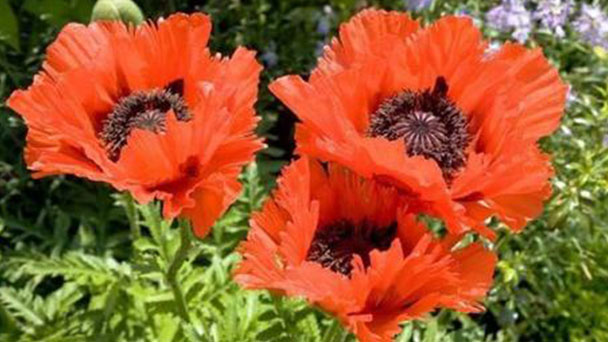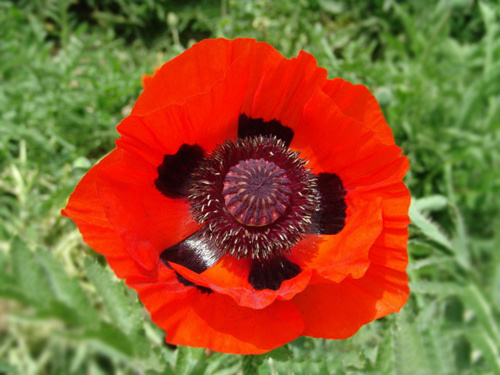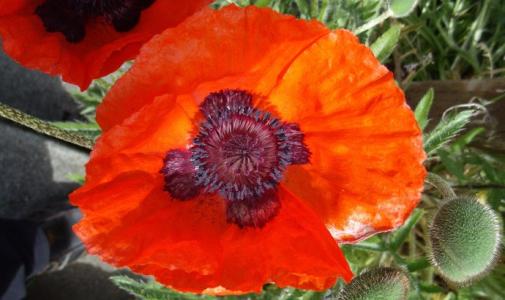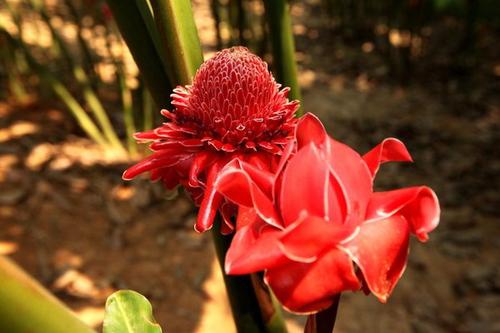Oriental poppy (Papaver orientale) profile
Written by Maggie
Apr 01 2021

Oriental poppy (Papaver orientale L.) is a perennial herb of the genus Papaver in the Papaver family. Oriental poppy (Papaver orientale) is setae, with milky liquid, 60 -- 90 cm tall (over 100 cm in cultivators), erect, cylindrical, with setae, nearly spreading or appressing; This plant is cold-resistant, because its flowers out of the color change, especially beautiful, so in various places as perennial root flowers have been introduced and cultivated. The flowers signify obedience and peace.
Oriental poppy picture

Oriental poppy (papaver orientale) ino
| Botanical Name | Papaver orientale |
| Common Names | Oriental poppy |
| Plant Type | Herbaceous perennial flower |
| Sun | Full sun |
| Hardiness Zones | 3 to 9 (USDA) |
| Flower color | Orange, red, pink, purple, white, peach, maroon, salmon |
| Native Area | Asia |
| Mature size | 2.00 to 3.00 feet tall, 3.00 to 6.00 feet wide |
Morphological characteristics of oriental poppy (papaver orientale)
Stems
Oriental poppy (Papaver orientale) is a perennial herb with bristles and milky juice. Roots are fusiform, whitish. The stem is simple 1, 60 -- 90 cm tall (over 100 cm in cultivators), erect, terete, covered with nearly spreading or appressing setae.
Leaf
Basal leaf blade outline of Oriental poppy (Papaver orientale) is ovate to lanceolate, petioles 20 -- 25 cm long (longer for growers), bipinnately deeply lobed, lobes lanceolate or oblong, sparsely dentate or incised, green on both surfaces, setae; Cauline leaves are numerous, alternate, homobasal leaves, but smaller, lower leaves long-stalked, uppermost leaves sessile.
Flowers
The flowers of Oriental poppy (Papaver orientale) are solitary; Pedicels are extended, densely setose; Buds are ovate or broadly ovate, 2-3 cm long, bristles extended; Oriental poppy (Papaver orientale) has 2 sepals, sometimes 3, green outside, autoload inside; Petals 4-6, broadly ovate or fan-shaped, (3-) 5-6 (-8) cm long, short clawed at base, coarsely veined abaxially, red or dark red, sometimes with purplish-blue spots on claws; Stamens are numerous, filaments filiform, lower part expanded, dark purple, anthers oblong, purplish blue. Stigmas 13-15 (-18), radiate, purplish blue, even composed of flat discoid with margin distantly coarsely toothed.
Fruit
Capsule of Oriental Poppy (Papaver Orientale) is subglobose, 2-3.5 cm in diameter, pale, glabrous. Seeds are round, reformed, brown, with broad stripes and small pores.
Ecological habits of oriental poppy (papaver orientale)
Oriental Poppy (Papaver Orientale) prefers sunny, fertile and well-drained sandy loam.Harder to cold, cultivated in North China, with taproots, not resistant to transplantation.
How to grow and care for oriental poppy (papaver orientale)
Light
Give your Oriental poppies full sun. Not solely will this promote higher flowering, however it will additionally minimize the probabilities of a powdery mildew infestation, which is a practicable trouble with these plants.
Soil
Grow Oriental poppy in a well-drained soil enriched with compost. It prefers impartial to barely acid pH. Root rot can happen in soil that does no longer drain well.
Water
During the blooming length (starting when the bud forms), provide Oriental poppy 1 inch of water per week. Otherwise, water when the soil is dry, however, no longer overwater, especially all through dormancy.
Temperature and humidity
Oriental poppy will develop in any everyday temperature and humidity prerequisites inside planting zones three to 7. Some cultivars are labeled for zones up to 9, however generally, the plant does no longer decide upon excessive warmth and humidity.
Fertilizer
Use a slow-release fertilizer in spring. Alternatively, side-dress the soil with compost or manure tea.

Oriental poppy toxicity
You have likely offered ingredients that have poppy seeds and can also surprise you if you should harvest the seeds from your very own Oriental poppies and reproduce that flavor. However, the poppy seeds used in delicacies generally come from opium poppy vegetation (Papaver somniferum). The seeds of your P. orientale can also or may also no longer be edible, however do not anticipate them to style like the poppy seeds you experience on that favourite bagel at the espresso shop.
Papaver somniferum and many different poppy plant life are toxic, some incredibly toxic, so it is assumed that papaver orientale is additionally toxic, and none of the plant must be ingested. According to the North Carolina State Extension service, Papaver orientale has low-severity toxicity characteristics, and all components of the plant may additionally be poisonous, such as the juice.
Oriental poppy varieties
Papaver orientale 'Livermere': Also known as 'Beauty of Livermere'; scarlet pink flower; two to three ft tall; hardiness zones three to 8
Papaver orientale 'Bolero': Purple-red flower with red eyes; 1 to two ft tall; hardiness zones three to 8
Papaver orientale 'Fireball': Bright orange, semi-double or double blooms; compact, at solely 1 foot tall; hardiness zones three to 9
Papaver orientale 'Princess Victoria Louise': Large (6- to 8-inch) salmon-pink blooms; two to three toes tall; hardiness zones 3 to 8
Papaver orientale 'Patty's Plum': Heavily textured, plum-colored blooms; two to three toes tall; hardiness zones three to 8
Propagating oriental poppies
Poppies can be divided and may additionally want to have this completed as soon as about each 5 years if the plantings grow too crowded. Division can be a little challenging, due to the plant's deep taproot. It's pleasant to do this in late summer, properly after the blooms have surpassed and the plant has entered dormancy.
Carefully dig up the complete plant clump, digging deep to get beneath the lengthy taproots. Divide the clump by way of slicing vertically via the root mass so that every component has one or extra eyes plus some taproot and stem. Plant the sections so their tops are three inches under the soil line.
How to grow oriental poppies from seed
Direct sowing is the trendy technique for developing Oriental poppies. The seeds want bloodless to germinate, so most gardeners sow the seeds in fall, when the soil has cooled after the warmth of late summer. If you pass over the fall plating, you can sow seeds in spring, about one month earlier than the remaining frost.
Rake the soil so it is clean and free of rocks. Scatter the seeds, then cowl them very gently with soil; they want some daylight for germination. And it is all you need to do. Nature takes care of the rest. When the snow melts and the floor warms up in spring, the seeds will germinate and commence their growth. Be certain to mark the planting location due to the fact you may not see the flowers for many months, and you would possibly overlook the place to put them.
The distribution of oriental poppy (papaver orientale)
Oriental Poppy (Papaver Orientale) is originally from the Mediterranean region and is widely cultivated as ornamental flowers in Taiwan.
Garden uses of oriental poppy (papaver orientale)
Oriental Poppy (Papaver Orientale) has been introduced and cultivated as a perennial flower throughout the country. Blossoms are very bright and beautiful, very popular with people. Oriental poppy (papaver orientale) can be used for flower beds and garden layout.

Latest Updated
- Benefits of Bugleweed - 7 Science-backed Health Benefits
- Bugleweed Dangers & Side Effects - Is It Poisonous?
- How to Plant Evergreen Trees - What You Should Know
- When to Plant Evergreens - Grow Guide for Evergreen Trees
- 12 Wonderful Evergreen Shrubs for Your Garden
- 12 Popular Evergreen Plants with Pictures for Beginners
- When And How To Prune A Lilac Bush Like a Pro
- How to Grow & Care for Lilac Vine (Hardenbergia Violacea)
- Japanese Lilac Tree (Syringa Reticulata) Care & Propagation Guide
- Shumard Oak Pros and Cons - What to Know
Popular Articles
- Winter maintenance of Antirrhinum Majus
- How to Grow Terminalia Mantaly Tree
- How to Grow and Care for Crossostephium Chinense
- How to grow Antirrhinum Majus in spring
- Peristeria Elata (Dove Orchid) Profile: Info & Care Guide
- Underwatered Snake Plant (Sansevieria Trifasciata) - Signs And How To Fix
- How to Care for Brazilian Jasmine Plant (Mandevilla Sanderi)
- How to Grow & Care for Graptopetalum Purple Delight in Summer
- Rosa Chinensis (China Rose): Plant Growing & Care Tips
- How to Care for Baby Sun Rose (Aptenia Cordifolia)